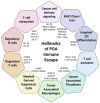Mechanisms Governing Immunotherapy Resistance in Pancreatic Ductal Adenocarcinoma
- PMID: 33584701
- PMCID: PMC7876239
- DOI: 10.3389/fimmu.2020.613815
Mechanisms Governing Immunotherapy Resistance in Pancreatic Ductal Adenocarcinoma
Abstract
Pancreatic ductal adenocarcinoma (PDA) is a lethal malignancy with an overall 5-year survival rate of 10%. Disease lethality is due to late diagnosis, early metastasis and resistance to therapy, including immunotherapy. PDA creates a robust fibroinflammatory tumor microenvironment that contributes to immunotherapy resistance. While previously considered an immune privileged site, evidence demonstrates that in some cases tumor antigen-specific T cells infiltrate and preferentially accumulate in PDA and are central to tumor cell clearance and long-term remission. Nonetheless, PDA can rapidly evade an adaptive immune response using a myriad of mechanisms. Mounting evidence indicates PDA interferes with T cell differentiation into potent cytolytic effector T cells via deficiencies in naive T cell priming, inducing T cell suppression or promoting T cell exhaustion. Mechanistic research indicates that immunotherapy combinations that change the suppressive tumor microenvironment while engaging antigen-specific T cells is required for treatment of advanced disease. This review focuses on recent advances in understanding mechanisms limiting T cell function and current strategies to overcome immunotherapy resistance in PDA.
Keywords: PD-1; PD-L1; T cell; exhaustion; immunosuppression; immunotherapy; pancreatic cancer; pancreatic ductal adenocarcinoma.
Copyright © 2021 Schmiechen and Stromnes.
Conflict of interest statement
IS serves on the scientific advisory board for Luminary Therapeutics and Immunogenesis. The remaining author declares that the research was conducted in the absence of any commercial or financial relationships that could be construed as a potential conflict of interest.
Figures



Similar articles
-
Rational combinations of immunotherapy for pancreatic ductal adenocarcinoma.Chin Clin Oncol. 2017 Jun;6(3):31. doi: 10.21037/cco.2017.06.04. Chin Clin Oncol. 2017. PMID: 28705008 Free PMC article.
-
Combination PD-1 and PD-L1 Blockade Promotes Durable Neoantigen-Specific T Cell-Mediated Immunity in Pancreatic Ductal Adenocarcinoma.Cell Rep. 2019 Aug 20;28(8):2140-2155.e6. doi: 10.1016/j.celrep.2019.07.059. Cell Rep. 2019. PMID: 31433988 Free PMC article.
-
Challenges and Opportunities for Pancreatic Cancer Immunotherapy.Cancer Cell. 2020 Dec 14;38(6):788-802. doi: 10.1016/j.ccell.2020.08.004. Epub 2020 Sep 17. Cancer Cell. 2020. PMID: 32946773 Free PMC article. Review.
-
Immune therapies in pancreatic ductal adenocarcinoma: Where are we now?World J Gastroenterol. 2018 May 28;24(20):2137-2151. doi: 10.3748/wjg.v24.i20.2137. World J Gastroenterol. 2018. PMID: 29853732 Free PMC article. Review.
-
Differential Effects of Depleting versus Programming Tumor-Associated Macrophages on Engineered T Cells in Pancreatic Ductal Adenocarcinoma.Cancer Immunol Res. 2019 Jun;7(6):977-989. doi: 10.1158/2326-6066.CIR-18-0448. Epub 2019 Apr 26. Cancer Immunol Res. 2019. PMID: 31028033 Free PMC article.
Cited by
-
Natural Killer Cells and Dendritic Cells: Expanding Clinical Relevance in the Non-Small Cell Lung Cancer (NSCLC) Tumor Microenvironment.Cancers (Basel). 2021 Aug 11;13(16):4037. doi: 10.3390/cancers13164037. Cancers (Basel). 2021. PMID: 34439191 Free PMC article. Review.
-
CD39 deletion in TCR-engineered T cells enhances antitumour immunity.Gut. 2024 Apr 5;73(5):716-717. doi: 10.1136/gutjnl-2023-330424. Gut. 2024. PMID: 37898545 Free PMC article. No abstract available.
-
Macrophage Migration Inhibitory Factor (MIF) and D-Dopachrome Tautomerase (DDT): Pathways to Tumorigenesis and Therapeutic Opportunities.Int J Mol Sci. 2024 Apr 29;25(9):4849. doi: 10.3390/ijms25094849. Int J Mol Sci. 2024. PMID: 38732068 Free PMC article. Review.
-
Apigenin Targets MicroRNA-155, Enhances SHIP-1 Expression, and Augments Anti-Tumor Responses in Pancreatic Cancer.Cancers (Basel). 2022 Jul 25;14(15):3613. doi: 10.3390/cancers14153613. Cancers (Basel). 2022. PMID: 35892872 Free PMC article.
-
Role of noncoding RNAs in pancreatic ductal adenocarcinoma associated cachexia.Am J Physiol Cell Physiol. 2022 Dec 1;323(6):C1624-C1632. doi: 10.1152/ajpcell.00424.2022. Epub 2022 Oct 24. Am J Physiol Cell Physiol. 2022. PMID: 36280389 Free PMC article. Review.
References
-
- Howlader N, Noone A, Krapcho M, Miller D, Brest A, Yu M, et al. SEER Cancer Statistics Review, 1975-2016. Bethesda, MD: National Cancer Institute; (2019). Available at: https://seer.cancer.gov/csr/1975_2016/.
-
- Huang L, Jansen L, Balavarca Y, van der Geest L, Lemmens L, Van Eycken L, et al. Stratified survival of resected and overall pancreatic cancer patients in Europe and the USA in the early twenty-first century: a large, international population-based study Lei. BMC Med (2018) 16. 10.1186/s12916-018-1120-9 - DOI - PMC - PubMed
Publication types
MeSH terms
Grants and funding
LinkOut - more resources
Full Text Sources
Other Literature Sources
Medical
Research Materials

